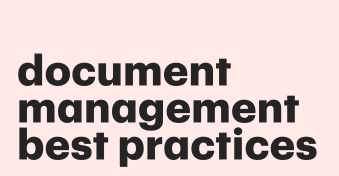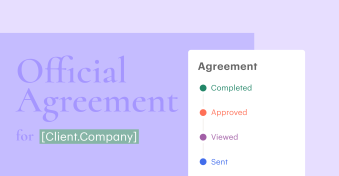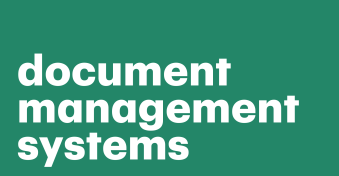Document management is the practice of organizing, storing, and tracking documents in a structured and efficient manner.
Because an organization is often bound by the documents it creates, keeping track of paperwork becomes a necessity early on.
However, managing documents doesn’t have to be a burden.
Managing documents correctly can lead to increases in productivity, reductions in administrative overhead, and improved opportunities for team collaboration.
Let’s take a closer look at how to manage documents, what those workflows look like, and how you can use specialized document management systems to do more with your files.
Key takeaways
- Every organization will need to manage and maintain documents during their lifespan to ensure compliance with government regulations and industry standards.
- Properly managed documents can lower administrative overhead while increasing team productivity.
- Implementing a scalable document management solution can be tricky, but document management software and related tools can help.
Getting started with document management
There are hundreds of ways to manage electronic documents.
Most systems are open-ended, meaning that you’ll have a lot of latitude when implementing a document and file management system.
However, depending on your organizational goals, this may be challenging.
Before getting started, it helps to have a clear vision about what type of document solution you need, what you intend for it to do, and why you need one in the first place.
1. Determine your document management goals
Before you start digitizing your paper documents or focusing on document naming conventions and formats, take a step back and consider the underlying reasons that you want to manage documents in the first place.
What are your ultimate goals with document management?
There are several reasons why you might want to improve your internal file management solution, including any of the following:
- Increasing worker productivity.
- Streamlining filing operations.
- Mitigating risks associated with file loss.
- Reducing paper waste.
- Improving informational security.
- And more.
Prior to making changes, take stock of the challenges that you currently face with your documents and determine the most critical issues that you intend to address.
A document solution that focuses on solving information retrieval delays for a sales team may look vastly different from one that tries to centralize and secure access to sensitive documents for corporate executives.
Keep in mind that it’s possible for one organization to have multiple document repositories within your organization.
According to the data, most companies end up using four separate repositories rather than trying to create a single, unified system.
Take the time to figure out what you intend to do with document management, and how the document storage solution you intend to implement will help your organization succeed.
2. Evaluate all users & use cases
At the end of the day, document management isn’t just about keeping documents organized.
It’s also about serving the users who need to access those files and helping to accommodate their unique needs.
Effective document management needs to take user information into account.
Before trying to build a new home for your documents, ask yourself:
- Who is using the system?
- What do they need it for?
- How will it help them?
For example, a sales team may need access to a repository of custom proposal templates and contracts so that they can quickly build documents and pursue potential leads.
However, a repository built for that use case won’t help a customer support or service repair team, who may need access to technical information about how products work or how to repair them.
If you create a filing system without the users in mind, it’s easier to overlook important documents, features, and automation opportunities that could make the system more useful within the user’s workspace.
3. Identify all required features
From personalized document dashboards to cloud storage and real-time document sharing, there are hundreds of features that can be built into a document management system.
However, every feature won’t be useful to every user.
Rather than building a kitchen sink of features into your document management system, take some time to consider what your system needs to do and which features will best support team members in their designated roles.
Some basic features, like basic document security or the ability to generate, organize, store, and quickly access documents, will be useful for a large number of users.
On the other hand, features like optical character recognition (OCR), tagging and metadata creation, or limiting document access may only be useful in certain circumstances.
You’ll need to determine which features should be available to users and how those capabilities will impact your digital documents.
Keep in mind that too many user-accessible features can add a layer of complexity to your document management system.
While you can solve this issue by limiting many powerful features to system administrators and top-level users, be sure to give teams what they need to get the most from the system you build.
4. Consider document type, lifecycle & classification
Most documents aren’t evergreen. They need to be updated and maintained over the course of their life.
This is true for sales contracts, support documentation, financial forms and disclosures, and more.
Unless a document is part of a transaction record, it’s likely that it will need to be accessed, reviewed, and update in the future.
When building your document management system, take the time to consider how best to manage a document depending on its lifecycle and classification.
While it’s true that some digital files only need to be saved for posterity and as a point of reference, others will need to be handled and managed as the needs of the business evolve.
You may want to organize files according to those needs.
For example, it might make the most sense to store invoices and similar financial documents as PDF files with view-only access.
This allows users to review that information but disables the ability to move, change, or otherwise modify the file.
On the other hand, day-to-day files like technical spec sheets or sales contracts may need to be duplicated, edited, and shared with external users before being signed and stored within your document repository.
These documents could benefit from version control and cloud-based collaboration tools in a way that “view-only” documents never will.
Ultimately, how these documents need to be classified and handled will play a major role in how they should be managed and stored within your index.
5. Create scalable document structures
When building an effective document management system, one of the best things you can do is take the time to create a filing solution that is both flexible and scalable.
Solutions that fit into this category make it easy for your file system to evolve and grow over time. To create scalable structures, you’ll need to consider each of the following:
- The types of documents you regularly receive and intend to store within your document repository.
- Main folders and subfolders used to store your documents, how they relate to one another, and how they should be organized.
- Naming conventions you intend to use for the majority of files within a given category.
- Any methods used to link or connect documents using metadata (tagging, internal document links, etc.).
The basic infrastructure you intend to use is the digital equivalent to a physical filing cabinet used to store documents.
Protip: You can also get very granular in the types of “documents” you store. For example, PandaDoc offers a content library that allows you to store customizable text snippets. While these aren’t documents in the traditional sense, they still need to be stored and managed in a way that maximizes their usability.
By setting up a system of file names and file types early, it will be easier to sort through the repository, find documents quickly, and share them with the appropriate individuals.
As a rule, you’ll want to aim for a structure that scales well and is easy for users to navigate.
While some document management software will have built-in tools to assist with this (tagging, document linking, etc.), don’t rely too heavily on systematic tools for navigation.
Doing so can create problems if you ever leave a specific system or storage platform.
6. Set access permission and controls
Even in a small business, it’s probable that some documents require enhanced security or a restricted level of access.
While this is certainly the case for business documents dealing with proprietary information or marketing intelligence, access control is rarely as simple as having an on/off switch.
To implement these permissions properly, you’ll need to know:
- Who needs access to which documents.
- How you’ll set those permissions.
- What roles each user needs.
For example, you might want to set up your sales repository so that regular team members can only create and modify copies of your master template.
While that functionality is critical to their job role, you may not want them to make sweeping changes that impact the entire team.
Instead, it might be best to restrict global editorial access to a few individuals, like team manager or members of the marketing team who write the copy or design and format the proposals.
Even there, you may want additional restrictions. Perhaps team managers shouldn’t have the ability to delete documents.
You might want to restrict that access to sales directors or executives or VPs and above.
While these needs will evolve as your organization grows, it’s best to look to the future and build a system that anticipates these inflection points.
All-in-one vs specialized document repositories
When deciding how best to manage documents, you’ll ultimately reach a fork in the road regarding your management strategy.
One solution is to use a shared, unified repository for all documents.
The other option revolves around splitting your documents into different repositories based on type and use case.
Both approaches have pros and cons. Let’s take a closer look at each option.
All-in-one repositories
Example solutions: Dropbox, Box, Google Drive, Microsoft OneDrive, Amazon Drive.
Pros: Low cost; open-ended storage options; built-in security; stores all document types; connects easily with company tech stack; offers built-in security options.
Cons: Lacks specialized use cases and integrations; offers limited functionality beyond document storage and management.
Generalized, document-agnostic storage solutions are some of the best document management options available in today’s online landscape.
These platforms have some of the world’s best-known companies attached to them — and for good reason.
Cloud-based service providers offer large quantities of digital storage for a relatively low cost.
Buying into that environment provides ways to store and access documentation using platforms that are both reliable and secure.
Many organizations end up using these storage services in conjunction with more specialized repositories for retention and archival purposes.
Documents that don’t need to be accessed regularly can reside here in perpetuity. If tagged and indexed correctly, locating essential documents can be accomplished in seconds.
However, the major downside to these platforms is that document storage is often their only purpose.
While it’s possible to perform other tasks with them, like sharing files, long-term storage is the long-term goal for companies operating in this space.
Specialized repositories
Example solutions: PandaDoc, Salesforce, HubSpot CRM, Monday.com, Canva.
Pros: Diverse functionality for stored documents; often allows for specialized document creation; offers tools and use cases beyond document storage; connects easily with tech stack.
Cons: Higher costs than all-in-one storage; may only store documents of a certain format; long-term storage may be a secondary feature in some organizations.
As you might have guessed, specialized repositories are typically found on platforms with a more specific focus.
Because PandaDoc falls into this category, we’ll use ourselves as an example.
The PandaDoc platform functions as a document creation tool for company sales documents, including proposals, contracts, invoices, and more.
We offer end-to-end document lifecycle management, including from-scratch document creation (via our in-app editor) as well as long-term storage for all documents that utilize our platform.
The ability to manage sales docs from start to finish and beyond is huge for sales teams, particularly as contracts age through their lifecycle and come up for renewal.
We offer storage solutions as part of our subscription for precisely that reason.
But, while PandaDoc is great for sales teams, legal departments, or HR, it’s probably not the best solution for something like technical and support documentation.
There are other solutions out there that offer more robust functionality (although PandaDoc can still play a role, as well).
The same will be true with other specialized repositories. CRM solutions like Salesforce or HubSpot CRM are great for holding customer records and tracking relationships over the long term — but they may not be the best solution for all of your HR and accounting needs.
Many organizations love to use specialized repositories for specific types of files so that they can take advantage of the tools provided by a specific platform to improve productivity.
But most companies using these services will also need a global repository that can centralize the remainder of their information.
The good news is that there is a benefit to using both solutions. Integrations can allow your repositories to seamlessly talk to one another.
For example, PandaDoc can integrate with most document storage options to import and synchronize files even when they are stored externally.
This means that you can take advantage of the unique tools and even host some critical documents within a specialized repository while hosting the majority of your finalized documents within your unified system.
Managing digital transitions
Chances are, if you’re just starting out with document management, your organization is still using a number of paper documents.
That’s not uncommon. Roughly 72% of companies say that they use a mix of paper and digital documents while only 13% are fully digital.
This means that, no matter which apps you use for storing files or sharing documents, you’ll likely have to manage some part of the transition from paper to digital.
When setting up your document management system, consider each of the following:
- What does the digitization process look like?
- What happens to old files once they are digitized?
- Should everything move to an online repository?
- How should you prioritize the digitization of older files?
- Is digitizing everything worth the monetary investment?
When considering the digital transition, keep in mind that you’ll need to have a process for both old paper files and new documents that you receive from external organizations.
Often, government entities and other companies will only provide paper copies (via certified mail) for important documents.
You will need to determine whether these documents should be digitized, what priority they should be given, and how best to streamline that workflow.
Designing a system that can accommodate these necessities will prevent major headaches in the future.
Build (and store) better documents with PandaDoc
If you’re trying to figure out how best to manage documents over the long term, it’s best to go in with a plan.
Do your research and select the best document storage solutions for your purposes.
Have a file structure in mind that can scale with your organizational needs, and keep users and use cases at the forefront of your thought process.
All-in-one storage solutions like those discussed above are often the backbone of any document management process, but don’t overlook tools like PandaDoc and Salesforce that can both store documents and add tools to make your workforce even more efficient.
Finding the balance between onboard storage, properly managed documents, and high-end productivity tools is a delicate but important balance.
Ready to level up your document process?
Give PandaDoc a test drive with a free 14-day trial or sign up for a demo to get a personalized walkthrough and see how PandaDoc can integrate with your existing tech stack.
Disclaimer
PandDoc is not a law firm, or a substitute for an attorney or law firm. This page is not intended to and does not provide legal advice. Should you have legal questions on the validity of e-signatures or digital signatures and the enforceability thereof, please consult with an attorney or law firm. Use of PandaDocs services are governed by our Terms of Use and Privacy Policy.


